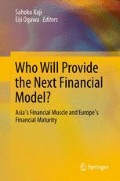Abstract
This paper focused on the asymmetric responses or misalignments of Asian currencies before and after the global financial crisis. Regional monetary cooperation is necessary for reducing such misalignments. Policy proposals for strengthening regional monetary cooperation in Asia after the global financial crisis are as follows: first, the monetary authorities should use an AMU and AMU Deviation Indicators to make policy dialogue regarding intra-regional exchange rate stability to solve the “coordination failure” of currency policy among Asian countries. Thus intra-regional exchange rates among Asian currencies can be stabilized. Second, the monetary authorities should introduce the surveillance of not only macroeconomic variables but also exchange rates into the surveillance process under the CMI. In addition, fiscal deficits should also be included in the surveillance process, especially after the lessons learnt from Europe Third, the monetary authorities should reduce or eliminate the IMF link to ensure effective currency swap arrangements under the CMI. Moreover, they should offer the AMRO the tasks of surveillance and the implementation of currency swap arrangements to eliminate CMI dependence on IMF surveillance.
This paper is a revised version of that presented at the international conference “Who will provide the next Financial Model? Asia’s Financial Muscle and Europe’s Financial Maturity” of the Joint Research Group “EU Economy” of EUSI in Tokyo, held at Keio University on December 10, 2011. The author is grateful for the helpful comments of Mei Kudo (Tsuda College) and other conference participants.
Access this chapter
Tax calculation will be finalised at checkout
Purchases are for personal use only
Notes
- 1.
The AMU is the weighted average of East Asian currencies where weights on currencies are based on shares of intra-regional trade and GDP measured at Purchasing Power Parity (PPP). Table 1 shows shares and weights of East Asian currencies. See Ogawa and Shimizu (2008) for the detailed explanation. Daily and monthly data are available at a website of RIETI (http://www.rieti.go.jp/users/amu/en/index.html#data). Kawai (2009a, b) and Kuroda and Kawai (2002) propose Asian Currency Unit (ACU) as well. Moon et al. (2006) propose Regional Currency Unit (RCU).
References
Institute for International Monetary Affairs (2007) Toward greater financial stability in the Asian region: exploring steps to create regional monetary units (RMUs), ASEAN+3 Finance Ministers Research Group
Institute for International Monetary Affairs (2008) Toward greater financial stability in the Asian region: measures for possible use of regional monetary units for surveillance and transaction, ASEAN+3 Finance Ministers Research Group
Jeffrey F, Wei SJ (1994) Yen bloc or dollar bloc? Exchange rate policies of the East Asian economies. In: Ito T, Krueger AO (eds) Macroeconomic linkage: savings, exchange rates, and capital flows. University of Chicago Press, Chicago, pp 295–355
Kawai M, Ogawa E, Ito T (2004) Developing a new regional financial architecture: a proposal. Mimeo, Tokyo
Kawai M (2009a) The role of an Asian currency unit. In: Hamada K, Reszat B, Volz U (eds) Towards monetary and financial integration in East Asia. Edward Elgar Publishing, pp 304–322
Kawai M (2009b) An Asian currency unit for regional exchange-rate policy coordination. In: Chung D-K, Eichengreen BJ (eds) Fostering monetary & financial cooperation in East Asia. World Scientific Publishing, Singapore, pp 73–112
Kuroda H, Kawai M (2002) Strengthening regional financial cooperation. Pac Econ Pap 332:1–35
Moon W, Rhee Y, Yoon D (2006) Regional currency unit in Asia: property and perspective, KIEP working paper, 06–03
Ogawa E, Ito T (2002) On the desirability of a regional basket currency arrangement. J Jpn Int Econ 16(3):317–334
Ogawa E, Iwatsubo K (2009) External adjustments and coordinated exchange rate policy in Asia. J Asian Econ 20(3):225–239
Ogawa E, Shimizu J (2008) A role of the Japanese yen in a multi-step process toward a common currency in east Asia. Fukino discussion paper series, 3
Ogawa E, Yoshimi T (2010) Analysis on β and σ convergences of East Asian currencies. Int J Intell Technol Appl Stat 3(5):237–263
Author information
Authors and Affiliations
Corresponding author
Editor information
Editors and Affiliations
Rights and permissions
Copyright information
© 2013 Springer Japan
About this chapter
Cite this chapter
Ogawa, E. (2013). Regional Monetary Cooperation in Asia. In: Kaji, S., Ogawa, E. (eds) Who Will Provide the Next Financial Model?. Springer, Tokyo. https://doi.org/10.1007/978-4-431-54282-7_19
Download citation
DOI: https://doi.org/10.1007/978-4-431-54282-7_19
Published:
Publisher Name: Springer, Tokyo
Print ISBN: 978-4-431-54281-0
Online ISBN: 978-4-431-54282-7
eBook Packages: Business and EconomicsEconomics and Finance (R0)

